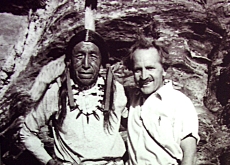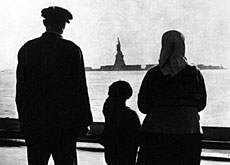American dreams come true for Swiss

The story of how a Native American medicinal plant was brought back to Switzerland and made into a best-selling natural remedy is revealed in an exhibition in Zurich.
Alfred Vogel discovered the healing qualities of the Echinacea purpurea through his friendship with a Sioux medicine man, Ben Black Elk.
In 1952, Vogel, a respected herbalist, spent several weeks with the Sioux in the Pine Ridge reserve in South Dakota to find out more about their culture and medicine.
There he met Black Elk, a 90-year-old medicine man, from the Lakota Oglala tribe. A friendship developed between the two men, based on mutual respect and a shared love of herbalism
Black Elk went as far as initiating Vogel in some of the secrets of tribal medicine, including the therapeutic effects of certain plants.
Before the Swiss returned to his native Basel, he received a handful of seeds belonging to the Echinacea or the purple coneflower.
The Lakota Oglala had been using the plant for generations as a remedy for coughs, digestive problems, wounds and infections. It was also used as an antidote against snakebites.
Healing properties
Soon after his return Vogel was able to test out the plant’s healing properties on himself after he injured his foot while cutting the grass. Impressed by the results, he took it into his laboratory to see if he could make it into a preparation.
The result was Echinaforce, which went on sale in 1963 and is now a popular remedy used to boost the immune system as well as fight off infections.
This remarkable tale is revealed in a special exhibition at Zurich’s North America Native Museum. It shows some of Vogel’s tools, such as test tubes and mortars used to prepare medicinal substances, as well as scales and medicinal herbs.
The museum is also showing some of the objects he gathered in the course of his extensive travels around the globe, and old photographs of Vogel with Black Elk.
“Without claiming to represent all the Swiss who went over to the United States, our intention was to show the experiences of a few Swiss who were among the first to go into the Native American territories,” museum ethnologist Monika Egli told swissinfo.
Part of the exhibition is dedicated to another Swiss pioneer among the Native Americans – Dorothee Jegen from Klosters in canton Graubünden.
Along with millions of her compatriots, Dorothee and her brothers, Peter and Christian, emigrated to the US at the end of the 19th century.
“At that time Switzerland was a very poor country which offered few work opportunities and where a large part of the population found it hard to make ends meet,” said Egli.
Pioneering bakers
The Jegen family went to Billings, known as “Magic City”, in Montana. They opened a bakery, selling their products to the pioneers, workers on the railway lines, gold prospectors and the local Crow tribe.
Not having much money, the tribe paid in kind, exchanging goods for home-crafted items such as pairs of moccasins, some of which can be seen at the museum.
However, life was not always easy for the intrepid Jegens or Yegens as they became known, as is shown by the display of a gleaming pistol owned by Dorothee so she could defend herself against bandits.
The bakery thrived though and the siblings opened a chain, becoming one of the wealthiest families in the area.
Dorothee later married a man from Graubünden and returned to Switzerland. Her two brothers remained in the US, with Christian becoming mayor of Billings and later, senator for Montana. The American dream come true.
swissinfo
The exhibition “Swiss pioneers in the land of the Sioux and Crow” runs until September 3, 2006 at the North America Native Museum, Zurich.
It is supported by Bioforce, the company set up by Alfred Vogel.
The exhibition is open from Monday-Friday (1300-1700), Wednesday (1300-2000), Saturday and Sunday (1000-1700). It is closed on Mondays.
In the US, an estimated 1.2 million Americans are of Swiss origin.
Many came in search of a better life between 1820-1890. At that time Switzerland offered few work opportunities. During this period, almost 175,000 Swiss emigrated to the US.
In 2005 there were 71,773 Swiss living in the US, and two-thirds have dual Swiss-US nationality.

In compliance with the JTI standards
More: SWI swissinfo.ch certified by the Journalism Trust Initiative

You can find an overview of ongoing debates with our journalists here . Please join us!
If you want to start a conversation about a topic raised in this article or want to report factual errors, email us at english@swissinfo.ch.